|
Family: Strigidae (typical owls)
Life
> Eukaryotes >
Opisthokonta
> Metazoa (animals) >
Bilateria >
Deuterostomia > Chordata >
Craniata > Vertebrata (vertebrates) > Gnathostomata (jawed
vertebrates) > Teleostomi (teleost fish) > Osteichthyes (bony fish) > Class:
Sarcopterygii (lobe-finned
fish) > Stegocephalia (terrestrial
vertebrates) > Tetrapoda
(four-legged vertebrates) > Reptiliomorpha > Amniota >
Reptilia (reptiles) >
Romeriida > Diapsida > Archosauromorpha > Archosauria >
Dinosauria
(dinosaurs) > Saurischia > Theropoda (bipedal predatory dinosaurs) >
Coelurosauria > Maniraptora > Aves
(birds) > Order: Strigiformes
Species indigenous to southern Africa
|
Asio
capensis (Marsh owl) The Marsh owl has
populations scattered across Botswana, Zimbabwe and large areas of South
Africa, living mainly in tall grassland. It usually hunts in the day, eating
insects but also small vertebrates, mainly hunting on the wing. It usually
nests in a slight depression in the ground, surrounded by dense grass and
weeds, making it difficult to find. Here it lays 2-6, usually 2-4 eggs,
which are incubated solely by the female, for about 27-28 days. The male
does all the hunting, storing his prey in "caches", to be eaten later by
either him or the female. The chicks stay in the nest for about 14-18 days,
after which they crawl around the surrounding bush for a few weeks, at least
until they learn to fly, becoming independent about a month later. |
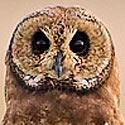 |
|
Bubo
africanus (Spotted eagle-owl) The Spotted eagle-owl is a familiar bird in many parts of
southern Africa, and it lives in a wide range of habitats. It has an
extremely varied diet, eating anything from poisonous snakes and carrion to
falcons and insects. It breeds in most months in the year, nesting in a variety
of different places. There are usually 2-3 chicks in one brood, up to 6 chicks
in good years. Juveniles are only fully independent 4 months after leaving the
nest. |
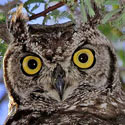 |
|
Bubo
capensis (Cape eagle-owl) The Cape eagle-owl can be seen in many parts of southern
Africa, but nowhere is it common. It lives in rocky,
sometimes mountainous areas, in various vegetation types. Most of its diet
consists of mammals, but it also feeds on birds and invertebrates. Amazingly,
it can carry prey that is 4,5 kg, or 4 times its weight! It nests in
scrapes in the ground, often on ledges or between cliffs. It lays 1-3 eggs, and
incubation lasts for 34-38 days, the female doing most of it, with the male
sometimes taking over while the female feeds. After fledging, juveniles stay
dependent on their parents for 2-3 months, before leaving completely. |
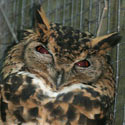 |
|
Bubo
lacteus (Verreaux's eagle-owl, Giant eagle owl) The Verreaux's
eagle-owl occurs across sub-Saharan Africa, mainly occupying arid savanna
and forest. It mainly eats mammals and birds, including large species such
as the Pel's fishing owl. It is an extremely
agile hunter for its size, and can actually catch smaller birds in flight!
It uses stick nests constructed by other birds, such as weavers, crows and
raptors. Here it lays 2 eggs, which are incubated solely by the female, for
about 38-39 days, who is fed at night by the male. Of the two chicks only
one survives, the other obtains less food from its parents, and usually dies
of starvation after 2-3 weeks. The surviving chick stays in the nest for
about 2 months, after which he remains dependent on his parents for 1-2 more
years. |
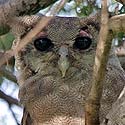 |
|
Glaucidium
capense (African barred owlet, Barred owl)
The African barred owlet is uncommon in most areas of its
range, being most prolific in the Miombo woodlands of Zimbabwe, and northern
Botswana. It prefers open woodland, with sparse undergrowth and a stream or
river nearby. It eats mainly invertebrates, due to its small size, but it
can eat dormice, small birds and reptiles. It nests in natural tree hollows,
sometimes 6 metres above ground, laying 2-3 eggs, which are presumed to be
incubated by the female. The chicks stay in the nest 32-33 days, after which
they learn to fly. They usually can fly at 42 days old. |
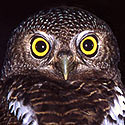 |
|
Glaucidium
perlatum (Pearl-spotted owlet, Pearl-spotted owl)
The Pearl-spotted owlet is common in many parts of
Southern Africa, where it can be found in open woodland, thorn savannah and bushveld. Unlike most owls,
it hunts in the day as well as the night, feeding
mainly on invertebrates, with small mammals and birds making up most of the
remainder of its diet. It mainly nests in tree holes, usually made by barbets or
woodpeckers. It lays 2-4 eggs, which are
incubated mainly by the female. Once hatched, chicks stay in the nest for 27-32
days, after which they live in bushes nearby, being fed by their parents for at
least 14 days longer. |
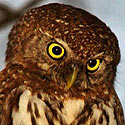 |
|
Otus
senegalensis (African scops-owl)
The African scops-owl can be found in many places in southern Africa, being
most abundant in central Namibia, Botswana and north-eastern South Africa.
It usually lives in arid savannah woodland. It can also be found
in valley bushveld in the Eastern cape. Being only 14-18 cm high, it mainly
eats invertebrates, with the remainder being made up of small birds, mammals and
reptiles. It usually nests in cavities in trees. It lays 2-4 eggs that are incubated by the
female, while the male hunts. The eggs hatch after about 22 days, and the chicks
remain in the nest for 25-28 days, after which they leave the nest for the
surrounding bush. |
 |
|
Ptilopsis
granti (Southern white-faced scops-owl, White-faced owl)
The Southern white-faced scops-owl is common in many parts of
southern Africa, living in a wide variety of habitats, ranging from Miombo
woodland to low thorn scrub. It mostly eats small mammals, with birds and
invertebrates making up the remainder of its diet. It uses stick nests made
by other birds as nesting sites, sometimes evicting falcons out of their nests,
before they have even finished laying their eggs. It lays 2-4 eggs, which are
incubated mainly by the female, with the male doing most of the hunting. The
chicks leave the nest at 28 days old for the surrounding bush, and are dependent
on their parents for at least 2 weeks more before leaving completely. |
 |
|
Scotopelia
peli (Pel's fishing-owl) The Pel's
fishing owl is restricted to areas surrounding major river systems, such as
the Zambezi River and the Okavango Delta. It is generally localized and
uncommon, preferring swamps or large tropical rivers surrounded by riverine
forest. It feeds almost exclusively on fish, catching them with a similar
style to the African fish eagle,
but it also occasionally catches young Nile crocodiles! It usually nests in
deep cavities in riverine trees, less than 20 metres from the water's edge.
Here it lays 2 eggs, which are incubated solely by the female for 33-38
days. Of the two chicks only one survives, the other obtains less food from
its parents, and usually dies of starvation after a few days. The surviving
chick stays in the nest for about 68-70 days, becoming fully independent a
few months later. |
 |
|
Strix
woodfordii (African wood-owl) The African wood-owl
occurs across Africa south of the Sahel, occupying a variety of
woodland and forest habitats. It mainly eats insects and small birds, but it
may also take snakes and small mammals. It usually nests in tree hollows,
which it uses repeatedly over multiple breeding seasons, even if it gets
flooded with water. It lays 1-3, usually 2 eggs, which are incubated solely
by the female for about 31 days, with the male doing all of the hunting. The
chicks are intensely cared for for the first week of their lives, after
which the female only visits the nest occasionally. They learn to fly when
they are about 50-60 days old, becoming fully independent a few months
later. |
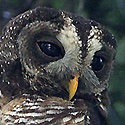 |
|
